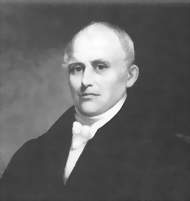- Samuel Slater
Infobox Person
name = Samuel Slater
image_size = 150px
caption = Samuel Slater (1768 – 1835) popularly called "The Father of the American Industrial Revolution"
birth_name =
birth_date =June 9 1768
birth_place =Belper ,Derbyshire ,England
death_date =April 21 1835
death_place =
death_cause =
resting_place =
resting_place_coordinates =
residence =
nationality = American
other_names =
known_for =
education =
employer =
occupation =industrialist
home_town =
title =
salary =
networth =
height =
weight =
term =
predecessor =
successor =
party =
boards =
religion =
spouse =
partner =
children =
parents =
relatives =
website =
footnotes =Samuel Slater (
June 9 1768 –April 21 1835 ) was an early Americanindustrialist popularly known as the "Founder of the AmericanIndustrial Revolution " because he brought British textile technology to America. A native ofEngland , he trained as an engineer and violated a British emigration law in 1789 that was designed to keep manufacturing technology within the country when he left forNew York in disguise as a farmer and hid papers in his coat lining. He soon found work inRhode Island replicating British factory equipment for a textile mill, and earned the owner's backing to design and build the first water powered mill in the United States.Slater established tenant farms and towns around his textile mills such as
Slatersville, Rhode Island . Due to his technical knowledge from Britain, he became a full partner and eventually went into business for himself and grew wealthy. By the end of Slater's life he owned thirteen spinning mills.Early years
Samuel Slater was born in
Belper ,Derbyshire ,England .In 1782, Slater was apprenticed to a local factory master,Jedediah Strutt , who had been doing business with Samuel's father. Originally Strutt had requested an older sibling but his father recommended Samuel instead because of his aptitude with mechanics. As a partner ofRichard Arkwright , Strutt was a pioneer in the use of the new British textile technology, and he is believed to have passed along the trade secrets to Slater over the course of the next seven yearsapprenticeship . Fact|date=February 2007After the
apprenticeship neared its end (around the time when Slater was 22), he began to recognize that the English textile factory was not so good. At this point, the desperate American textile industry was offering bounties of ₤100 to people with British technological knowledge. These had been offered because all attempts to obtain English models, by purchase or smugglingLife in America
In 1789, a Quaker
merchant by the name ofMoses Brown had decided to start his owntextile factory in Pawtucket,Rhode Island , and hired his son-in-law, William Almy, and nephew, Smith Brown, to operate the mill. Old Slater Mill Association. [http://www.slatermill.org/html/history.html "The Story of Samuel Slater."] Accessed September 6, 2006.] Housed in a former fulling mill, Almy & Brown, as the company was to be called, set about to make and sell cloth spun on spinning wheels, jennies, and frames.Operational challenges with the frames led Brown to seek out someone with experience with textile mills and the ability to reproduce Arkwright's machine. Slater offered his services and was put to work duplicating British factory equipment. After he proved his competency, Brown provided the funds to build a mill on the Blackstone River based on the Arkwright designs in his photographic memory. During construction, Slater made some adjustments to the designs to fit the needs of America. The result would be the first successful water-powered textile mill in America. Samuel's wife, Hannah Slater, also invented a type of thread made of cotton. Slater's machinery carded cotton and spun it into thread. [Samuel Slater entry, "Who Made the united states?" at PBS.org. [http://www.pbs.org/wgbh/theymadeamerica/whomade/slater_hi.html] Accessed 19 March 2008.]After creating this mill, he put the principles of management in place that would lead to success. The first children workers were hired in 1790 [ [http://www.brunswick.k12.me.us/bjh/depart/curric/nationgrows/virtualtelegraph/periods/period1/slaterbrownreport.htm Samuel Slater and Moses Brown Change America ] ] . Slater first attempted to populate the mill with women and children from far away, but that fell through due to the closeknit framework of the New England family. He then started tenant farms near his mills and brought in whole families(Amanda Roahrig), creating entire towns. [ [http://www.uh.edu/engines/epi384.htm No. 384: Samuel Slater ] ]
In 1793, now partners with Almy and Brown, Slater constructed a new mill for the sole purpose of textile manufacture under the name Almy, Brown & Slater. This mill, known today as
Slater Mill , still stands and operates as a museum dedicated to preserving the history of Samuel Slater and his contribution to American industry.In 1798 Samuel Slater split from Almy and Brown to build his own larger mill in partnership with his brother John, which he called the White Mill. ["The Columbia Encyclopedia, Sixth Edition", 2001-07. [http://www.bartleby.com/65/sl/Slater-S.html] Accessed 19 March 2008.] Slater estimated his wealth at close to one million dollars, and at the time of his death, he owned all thirteen textile mills. He later died on April 21, 1835 in Webster,
Massachusetts . He is buried in Mount Zion Cemetery in Webster.References
Bibliography
*G. S. White (1836, repr. 1967) Biography
*E. H. Cameron (1960) Biography
*W. R. Bagnall (1891), "Samuel Slater and the Early Development of Cotton Manufacture in the United States"External links
* [http://www.slatermill.org/ Slater Mill website]
Persondata
NAME= Slater, Samuel
ALTERNATIVE NAMES=
SHORT DESCRIPTION=industrialist
DATE OF BIRTH=June 9 1768
PLACE OF BIRTH=Belper ,Derbyshire ,England
DATE OF DEATH=April 21 1835
PLACE OF DEATH=
Wikimedia Foundation. 2010.
